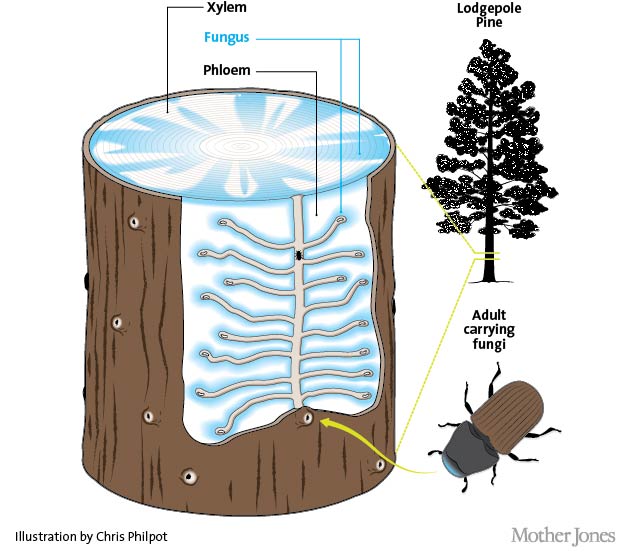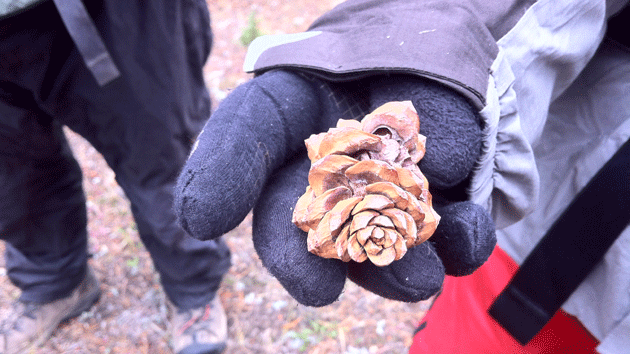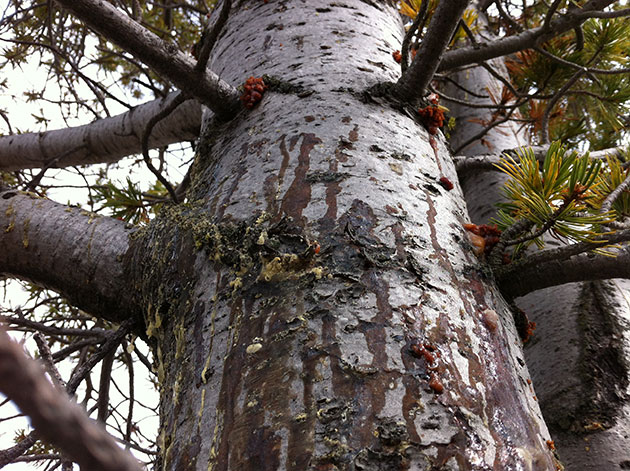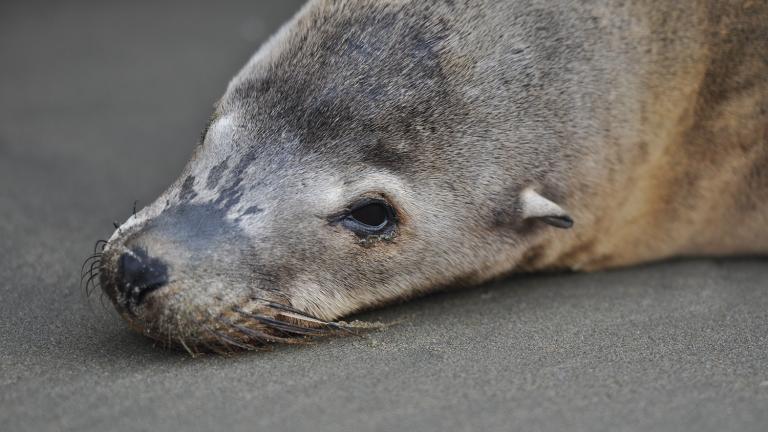This story was originally published by Mother Jones and is reproduced here as part of the Climate Desk collaboration.
There is an eerie feel to this grove of lodgepole pines that I can’t quite put my finger on as entomologist Diana Six tromps ahead of me, hatchet in hand, scanning the southwestern Montana woods for her target. But as she digs the blade into a towering trunk, it finally hits me: the smell. There’s no scent of pine needles, no sharp, minty note wafting through the brisk fall air.
Six hacks away hunks of bark until she reveals an inner layer riddled with wormy passageways. “Hey, looky!” she exclaims, poking at a small black form. “Are you dead? Yeah, you’re dead.” She extends her hand, holding a tiny oval, maybe a quarter of an inch long. Scientists often compare this insect to a grain of rice, but Six prefers mouse dropping: “Beetle in one hand, mouse turd in another. You can’t tell them apart.” She turns to the next few trees in search of more traces. Pill-size holes pock their ashen trunks — a sign, along with the missing pine scent, of a forest reeling from an invasion.
These tiny winged beetles have long been culling sickly trees in North American forests. But in recent years, they’ve been working overtime. Prolonged droughts and shorter winters have spurred bark beetles to kill billions of trees in what’s likely the largest forest insect outbreak ever recorded, about 10 times the size of past eruptions. “A doubling would have been remarkable,” Six says. “Ten times screams that something is really going wrong.”
Mountain pine, spruce, piñon ips, and other kinds of bark beetles have chomped 46 million of the country’s 850 million acres of forested land, from the Yukon down the spine of the Rocky Mountains all the way to Mexico. Yellowstone’s grizzly bears have run out of pinecones to eat because of the beetles. Skiers and backpackers have watched their brushy green playgrounds fade as trees fall down, sometimes at a rate of 100,000 trunks a day. Real estate agents have seen home prices plummet from “viewshed contamination” in areas ransacked by the bugs. And the devastation isn’t likely to let up anytime soon. As climate change warms the North American woods, we can expect these bugs to continue to proliferate and thrive in higher elevations — meaning more beetles in the coming century, preying on bigger chunks of the country.

From 2000 to 2014, bark beetles destroyed large swaths of forests in the American West — and they’re not done yet.
In hopes of staving off complete catastrophe, the United States Forest Service, which oversees 80 percent of the country’s woodlands, has launched a beetle offensive, chopping down trees to prevent future infestations. The USFS believes this strategy reduces trees’ competition for resources, allowing the few that remain to better resist invading bugs. This theory just so happens to also benefit loggers, who are more than willing to help thin the forests. Politicians, too, have jumped on board, often on behalf of the timber industry: More than 50 bills introduced since 2001 in Congress proposed increasing timber harvests in part to help deal with beetle outbreaks.
But Six believes that the blitz on the bugs could backfire in a big way. For starters, she says, cutting trees “quite often removes more trees than the beetles would” — effectively out-beetling the beetles. But more importantly, intriguing evidence suggests that the bugs might be on the forest’s side. Six and other scientists are beginning to wonder: What if the insects that have wrought this devastation actually know more than we do about adapting to a changing climate?

An adult mountain pine beetle lays her eggs under the bark. On her way, she disperses fungi that turn the trees’ tissue into food for her babies, eventually killing the tree.
Though they’re often described as pesky invaders, bark beetles have been a key part of conifer ecosystems for ages, ensuring that groves don’t get overcrowded. When a female mountain pine beetle locates a frail tree, she emits a chemical signal to her friends, who swarm to her by the hundreds. Together, they chew through the bark until they reach the phloem, a cushy resinous layer between the outer bark and the sapwood that carries sugars through the tree. There, they lay their eggs in tunnels and eventually a new generation of beetles hatches, grows up, and flies away. But before they do, the mature beetles also spread a special fungus in the center of the trunk. And that’s where things get really interesting.
Six focuses on the “evolutionary marriage” of beetle and fungi at her four-person lab at the University of Montana, where she is the chair of the Department of Ecosystems and Conservation Sciences. Structures in bark beetles’ mouths have evolved to carry certain types of fungi that convert the tree’s tissue into nutrients for the bug. The fungi have “figured out how to hail the beetle that will get them to the center of the tree,” Six says. “It’s like getting a taxi.” The fungi leave blue-gray streaks in the trees they kill; “blue-stain pine” has become a specialty product, used to make everything from cabins to coffins to iPod cases.
A healthy tree can usually beat back invading beetles by deploying chemical defenses and flooding them out with sticky resin. But just as dehydration makes humans weaker, heat and drought impede a tree’s ability to fight back — less water means less resin. In some areas of the Rocky Mountain West, the mid-2000s was the driest, hottest stretch in 800 years. From 2000 to 2012, bark beetles killed enough trees to cover the entire state of Colorado. “Insects reflect their environment,” explains renowned entomologist Ken Raffa — they serve as a barometer of vast changes taking place in an ecosystem.

Under the microscope, Diana Six picks up a dead mountain pine beetle in her Missoula lab.Shawn Gust
Typically, beetle swells subside when they either run out of trees or when long, cold winters freeze them off (though some larvae typically survive, since they produce antifreeze that can keep them safe down to 30 below). But in warm weather, the bugs thrive. In 2008, a team of biologists at the University of Colorado observed pine beetles flying and attacking trees in June, a month earlier than previously recorded. With warmer springs, the beetle flight season had doubled, meaning they could mature and lay eggs — and then their babies could mature and lay eggs — all within one summer.
That’s not the only big change. Even as the mountain pine beetles run out of lodgepole pines to devour in the United States, in 2011 the insects made their first jump into a new species of tree, the jack pine, in Alberta. “Those trees don’t have evolved defenses,” Six says, “and they’re not fighting back.” The ability to invade a new species means the insects could begin a trek east across Canada’s boreal forest, then head south into the jack, red, and white pines of Minnesota and the Great Lakes region, and on to the woods of the East Coast. Similarly, last year, the reddish-black spruce beetle infested five times as many acres in Colorado as it did in 2009. And in the last decade, scientists spotted the southern pine beetle north of the Mason-Dixon Line for the first time on record: in New Jersey, and later on, Long Island. As investigative journalist Andrew Nikiforuk put it in his 2011 book on the outbreaks, we now belong to the “empire of the beetle.”
In a weird way, all of this is exciting news for Six: She is not only one of the world’s foremost experts in beetle-fungi symbiosis, but proud to be “one of the few people in Montana who thinks bark beetles are cute.” (She’s even brewed her own beer from beetle fungi.) As a child, she filled her bedroom in Upland, Calif., with jars of insects and her fungus collection. But as a teenager, she got into drugs, quit high school, and started living on the streets. Nine years later, she attended night school, where teachers urged her to become the first in her family to go to college. And when she finally did, she couldn’t get enough: classes in microbiology and integrated pest management led to a master’s degree in veterinary entomology, then a PhD in entomology and mycology and a postdoc in chemical ecology, focused on insect pheromones.

Entomologist Diana Six, who has devoted her career to bark beetles, believes that the bugs might hold clues to saving our forests in the face of climate change.Shawn Gust
Six, 58, has light-green eyes ringed with saffron, and long silvery-blond hair streaming down shoulders, and she’s toned from fly-fishing and bodybuilding. As several fellow researchers stressed to me, she is a rare scientist who’s also a powerful communicator. “I think about what it means to be a tree,” she told a rapt audience at a TEDx talk about global forest die-offs. “Trees can’t walk. Trees can’t run. Trees can’t hide,” she continued, her sonorous voice pausing carefully for emphasis. “And that means that when an enemy like the mountain pine beetle shows up, they have no choice but to stand their ground.”
To a treehugger, that might seem a grim prognosis: Since trees can’t escape, they’ll all eventually be devoured by insects, until we have no forests left. Especially since, with our current climate projections, we might be headed toward a world in which beetle blooms do not subside easily, but instead continue to spread through new terrain.
But Six has a different way of looking at the trees’ plight: as a battle for survival, with the army of beetles as a helper. She found compelling evidence of this after stumbling across the work of Forest Service researcher Constance Millar, with whom she had crossed paths at beetle conferences.
Millar was comparing tree-core measurements of limber pines, a slight species found in the eastern Sierras of California that can live to be 1,000 years old. After mountain pine beetles ravaged one of her study sites in the late 1980s, certain trees survived. They were all around the same size and age as the surrounding trees that the beetles tore through, so Millar looked closer at tree ring records and began to suspect that, though they looked identical on the outside, the stand in fact had contained two genetically distinct groups of trees. One group had fared well during the 1800s, when the globe was still in the Little Ice Age and average temperatures were cooler. But this group weakened during the warmer 1900s, and grew more slowly as a result. Meanwhile, the second group seemed better suited for the warmer climate, and started to grow faster.

Pine beetles have increasingly attacked fragile whitebark pine trees, whose cones are an important food source for grizzly bears, Clark’s nutcrackers, red squirrels, and other animals in the Yellowstone area. Maddie Oatman
When beetle populations exploded in the 1980s, this second group mounted a much more successful battle against the bugs. After surviving the epidemic, this group of trees “ratcheted forward rapidly,” Millar explains. When an outbreak flared up in the mid-2000s, the bugs failed to infiltrate any of the survivor trees in the stand. The beetles had helped pare down the trees that had adapted to the Little Ice Age, leaving behind the ones better suited to hotter weather. Millar found similar patterns in whitebark pines and thinks it’s possible that this type of beetle-assisted natural selection is going on in different types of trees all over the country.
When Six read Millar’s studies, she was floored. Was it possible, she wondered, that we’ve been going about beetle management all wrong? “It just hit me,” she says. “There is something amazing happening here.”
Last year, Six and Eric Biber, a University of California-Berkeley law professor, published a provocative review paper in the journal Forests that challenged the Forest Service’s beetle-busting strategies. After scrutinizing every study about beetle control that they could get their hands on, they concluded that “Even after millions of dollars and massive efforts, suppression … has never effectively been achieved, and, at best, the rate of mortality of trees was reduced only marginally.”
Six points to a stand of lodgepoles in the University of Montana’s Lubrecht Experimental Forest. In the early 2000s, school foresters preened the trees, spacing them out at even distances, and hung signs to note how this would prevent beetle outbreaks. This “prethinned” block was “the pride and joy of the experimental forest,” Six remembers. But that stand was the first to get hit by encroaching pine beetles, which took out every last tree. She approached the university forest managers. “I said, ‘Boy, you need to document that,'” Six says. “They didn’t. They just cut it down. Now, there’s just a field of stumps.”
Six and Biber’s paper came as a direct affront to some Forest Service researchers, one of whom told me that he believes changing forest structure through thinning is the only long-term solution to the beetle problem. Politicians tend to agree — and beetle suppression sometimes serves as a convenient excuse: “It is perhaps no accident that the beetle treatments most aggressively pushed for in the political landscape allow for logging activities that provide revenue and jobs for the commercial timber industry,” Six and Biber wrote in the Forests review.
Take the Restoring Healthy Forests for Healthy Communities Act, proposed in 2013 by then-Rep. Doc Hastings (R-Wash.) and championed by then-Rep. Steve Daines (R-Mont.). The bill sought to designate “Revenue Areas” in every national forest where, to help address insect infestations, loggers would be required to clear a certain number of trees every year. Loggers could gain access to roadless areas, wilderness study areas, and other conservation sites. Once designated, their acreage could never be reduced. The zones would also be excluded from the standard environmental-review process.
Six and other scientists vehemently opposed these massive timber harvests — as did environmental advocates like the Sierra Club and Defenders of Wildlife, the latter warning that the harvests would take logging to “unprecedented and unsustainable levels.” The bill passed the House died in the Senate last year. But Daines, now a senator and one of 2014’s top 10 recipients of timber money, vows to renew the effort so as to “revitalize Montana’s timber industry” and “protect the environment for future generations.”
This summer, Six plans to start examining the genes of “supertrees” — those that survive beetle onslaughts — in stands of whitebarks in Montana’s Big Hole Valley. Her findings could help inform a new kind of forest management guided by a deeper understanding of tree genes — one that beetles have had for millennia.
If we pay close enough attention, someday we may be able to learn to think like they do. University of California-Davis plant sciences professor David Neale champions a new discipline called “landscape genomics.” At his lab in Davis, Neale operates a machine that grinds up a tree’s needles and spits out its DNA code. This technology is already being used for fruit tree breeding and planting, but Neale says it could one day be used in wild forests. “As a person, you can take your DNA and have it analyzed, and they can tell you your relative risk to some disease,” Neale says. “I’m proposing to do the same thing with a tree: I can estimate the relative risk to a change in temperature, change in moisture, introduction to a pathogen.”

Signs of beetle invasion on a whitebark pine tree in Montana’s Big Hole Valley.Maddie Oatman
Right now, foresters prune woodlands based on the size of tree trunks and density of stands. If we knew more about trees’ genetic differences, Neale says, “Maybe we would thin the ones that have the highest relative risks.” This application is still years off, but Neale has already assembled a group of Forest Service officials who want to learn more about landscape genomics.
Meanwhile, Six places her faith in the beetles. Whereas traditional foresters worry that failing to step in now could destroy America’s forests, Six points to nature’s resilience. Asked at TEDx how she wants to change the world, she responded, “I don’t want to change the world. We have changed the world to a point that it is barely recognizable. I think it’s time to stop thinking change and try to hold on to what beauty and function remains.”

Diana Six in her lab at the University of Montana.Shawn Gust




